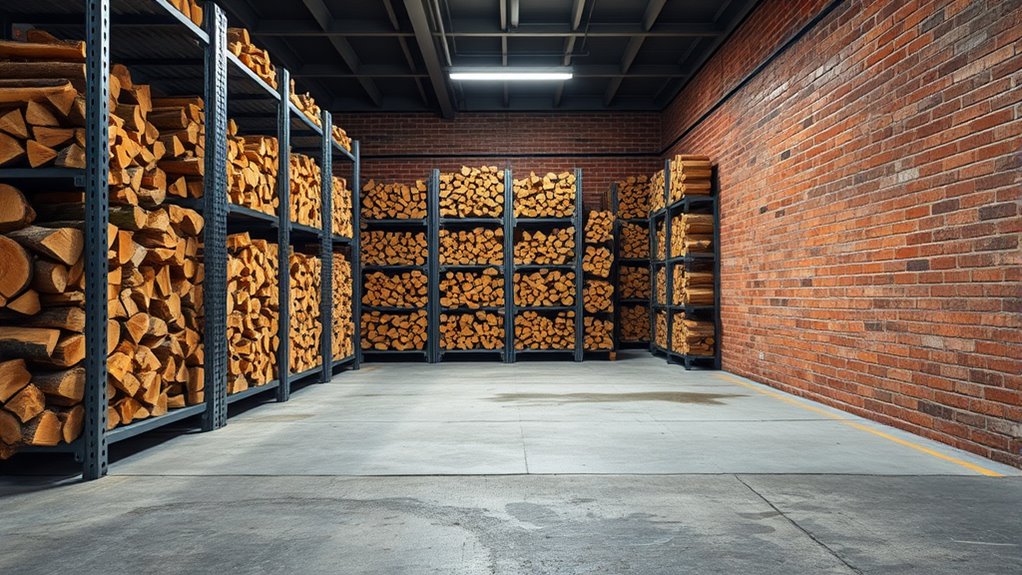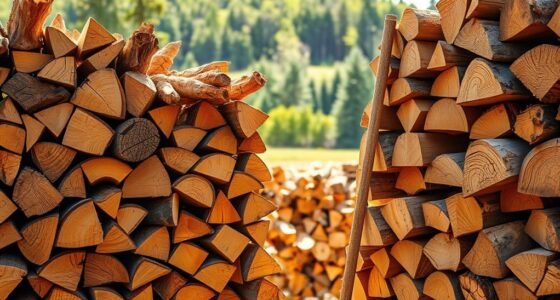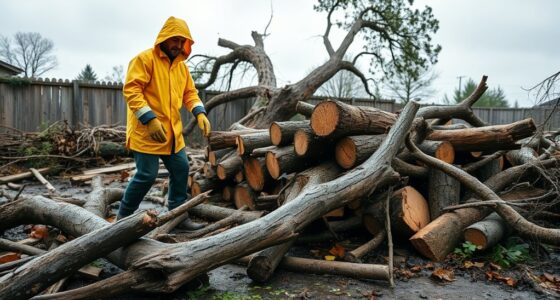When storing firewood in urban areas, you must follow local regulations that specify proper locations, safe distances (at least 20-30 feet from your home), and stacking limits (no more than 4 feet high). Use dry, level surfaces and elevate stacks off the ground for airflow. Regular inspections, pest control, and clear pathways improve safety. Violating these rules can lead to fines or fire code violations; if you keep exploring, you’ll get more detailed tips to stay compliant and safe.
Key Takeaways
- Local authorities may require permits and enforce storage location, methods, and height regulations for firewood.
- Keep firewood at least 20-30 feet from structures and on non-flammable surfaces to comply with safety standards.
- Regular inspections ensure pest control, moisture management, and structural integrity of storage areas.
- Proper ventilation, organization, and elevation prevent mold, pests, and fire hazards.
- Violating firewood storage rules can lead to fines, penalties, and fire code violations in urban areas.
Local Regulations and Ordinances
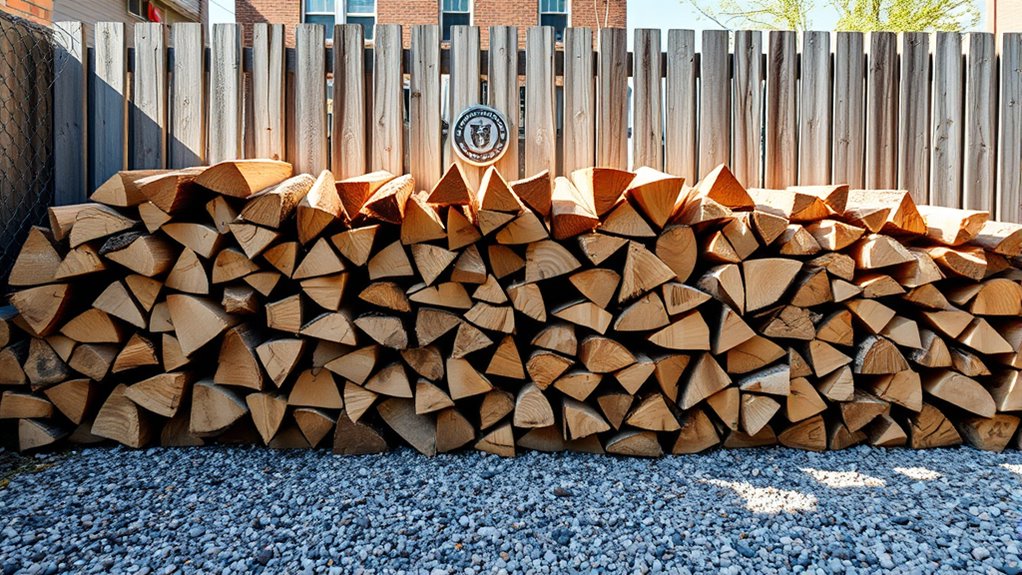
Local regulations and ordinances often specify how and where you can store firewood within city limits. These rules are designed to prevent fires caused by combustible materials stored improperly. You may need to obtain storage permits if your firewood storage exceeds a certain size or is located near structures or property lines. Many cities require firewood to be stacked a specific distance away from buildings, fences, and other combustible materials to reduce fire risk. Failing to follow these regulations can result in fines or orders to remove the storage. Always check with your local authorities before storing large amounts of firewood, and verify your setup complies with all ordinances. Staying informed helps you avoid penalties and keeps your property safe. Additionally, understanding fire safety regulations and how they relate to fire hazard mitigation can help you implement best practices for secure storage. Properly following these guidelines contributes to community safety and reduces the likelihood of accidental fires. Regularly reviewing local fire codes ensures ongoing compliance and safety for your property and neighbors. Being aware of storage duration limits can also prevent unintentional violations and promote responsible firewood management.
Proper Storage Locations and Placement
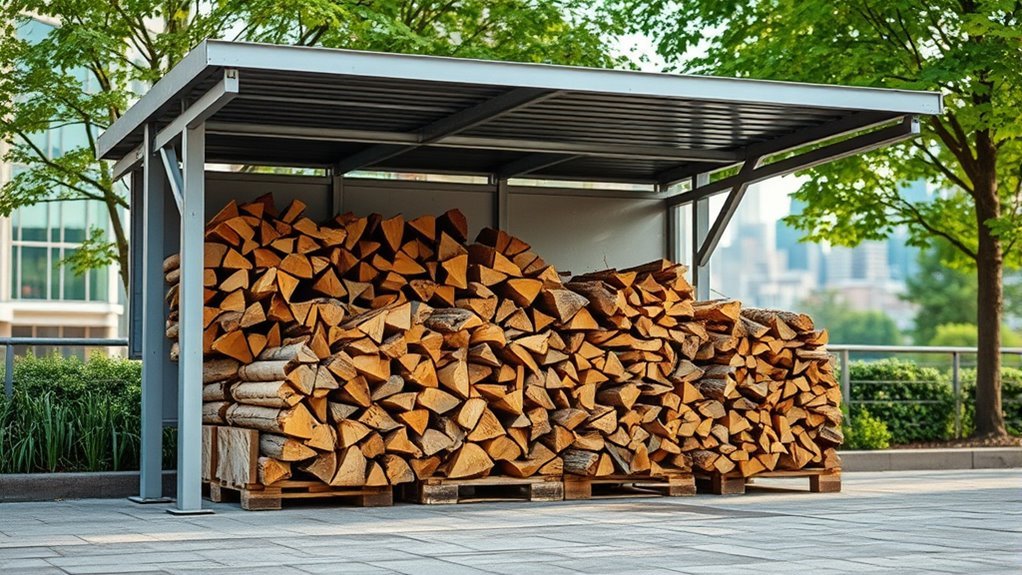
Choosing the right location for firewood storage is vital to mitigate fire risks and guarantee safety. You should place your firewood stacking away from your home, fences, and any structures to prevent accidental fires. A level, dry area is ideal, as moisture can lead to decay and pests. Keep your storage container placement at least 20 feet from combustible materials and make certain it’s on a non-flammable surface like gravel or concrete. Elevate your firewood stacking off the ground to promote airflow and prevent moisture buildup. Avoid tight corners or enclosed spaces where airflow is restricted. By selecting an open, well-ventilated area, you reduce fire hazards and protect your firewood from weather damage. Proper placement ensures safety and maintains the quality of your firewood. Understanding fire safety is essential for effective storage practices and risk mitigation. Additionally, incorporating proper ventilation can significantly decrease the risk of mold growth and insect infestation, ensuring your firewood remains dry and safe to burn. Ensuring adequate air circulation around your firewood is also crucial to prevent moisture accumulation and pest problems. Properly ventilated storage areas help in maintaining the firewood’s dryness and quality over time. Incorporating climate considerations when selecting your storage location can further enhance safety and preservation.
Ventilation and Pest Control Measures

To keep your firewood dry and pest-free, you need proper airflow design that promotes ventilation. Using pest barrier strategies helps prevent insects and rodents from accessing your storage area. Regular inspections guarantee you catch any issues early and maintain effective ventilation and pest control measures. Incorporating GMC tuning techniques can also optimize environmental conditions around your storage area for better preservation. Additionally, ensuring that your storage space is properly maintained can significantly enhance airflow and deter pests from settling in. Employing airflow management solutions designed specifically for outdoor storage can further improve airflow and reduce moisture buildup, which is essential for air quality and preventing mold growth.
Proper Airflow Design
Ensuring proper airflow in your firewood storage area is essential for maintaining wood quality and preventing pest infestations. Good ventilation helps keep moisture levels low, reducing mold and decay. To achieve optimal airflow, ensure sufficient chimney clearance around the storage site and install firebreak barriers to prevent pests from climbing in. Proper design involves spacing logs adequately and avoiding enclosed stacks. Consider this table for airflow insights:
| Aspect | Description | Impact |
|---|---|---|
| Chimney clearance | Maintain space around vents for circulation | Prevents blockages, boosts airflow |
| Firebreak barriers | Barriers prevent pest entry and movement | Reduces pest risk |
| Stack spacing | Keep logs apart for air circulation | Keeps wood dry and pest-free |
Pest Barrier Strategies
Effective pest barrier strategies combine proper ventilation with targeted pest control measures to keep pests out of your firewood storage. Good airflow prevents excess moisture, which attracts pests and promotes pest infestation. Use vents with fine mesh screens to allow ventilation while blocking rodent entry. Keep the storage area elevated off the ground to deter rodents and other pests. Seal cracks and gaps around walls, floors, and doors to eliminate entry points. Regularly clear debris and clutter that could harbor pests. Consider natural repellents or traps near storage areas to discourage rodents. Maintaining a clean, dry, and well-ventilated space reduces the likelihood of pest infestation and prevents rodents from gaining access. These strategies work together to protect your firewood supply efficiently. Proper pest identification is crucial for implementing effective control measures. Additionally, implementing integrated pest management techniques can further enhance your pest prevention efforts. Incorporating technology-driven solutions, like monitoring sensors, can help detect pest activity early and improve overall pest control. To maximize effectiveness, ensure your hours of operation for pest control services align with your maintenance schedule, making ongoing pest management more manageable.
Regular Inspection Practices
Regular inspections of your firewood storage area help maintain proper ventilation and catch pest issues early. Consistently check for signs of pests and ensure good airflow to reduce moisture buildup. Implement firewood rotation by moving older logs to the front, preventing mold and decay. Use moisture monitoring tools to keep wood dry, as damp wood attracts pests and promotes rot. During inspections, look for mold, insect activity, and any structural damage to your storage container. Clear out any debris or fallen leaves that could harbor pests. Make sure vents are unobstructed to promote airflow. Regularly monitoring moisture levels and rotating your firewood will keep it dry, pest-free, and safe for use. Additionally, paying attention to wood stove decor elements can enhance your space while keeping it functional and safe. Incorporating fathers’ guidance into your routine can also foster a greater sense of responsibility and care in maintaining your storage area. To further promote wood preservation, consider applying protective coatings to your logs to extend their usability.
Fire Safety and Distance Requirements
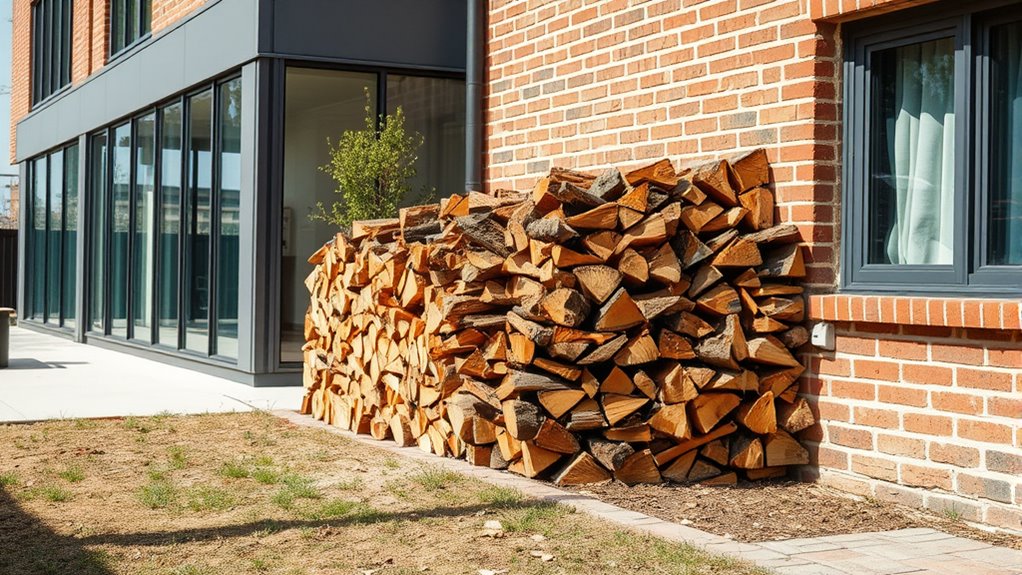
To minimize fire hazards, you must keep stored firewood at a safe distance from structures and ignition sources. Proper fire safety involves maintaining a clear space around your storage area, typically at least 30 feet from buildings, electrical equipment, and other heat sources. Additionally, avoid stacking firewood directly against walls or fences to prevent sparks or flames from spreading. The storage height also matters; keep firewood stacked no higher than 4 feet to reduce the risk of toppling and to ensure good airflow, which minimizes moisture buildup that can lead to mold or decay. Following these distance and height requirements helps prevent accidental fires and promotes safer firewood storage in urban environments.
Material Handling and Storage Containers
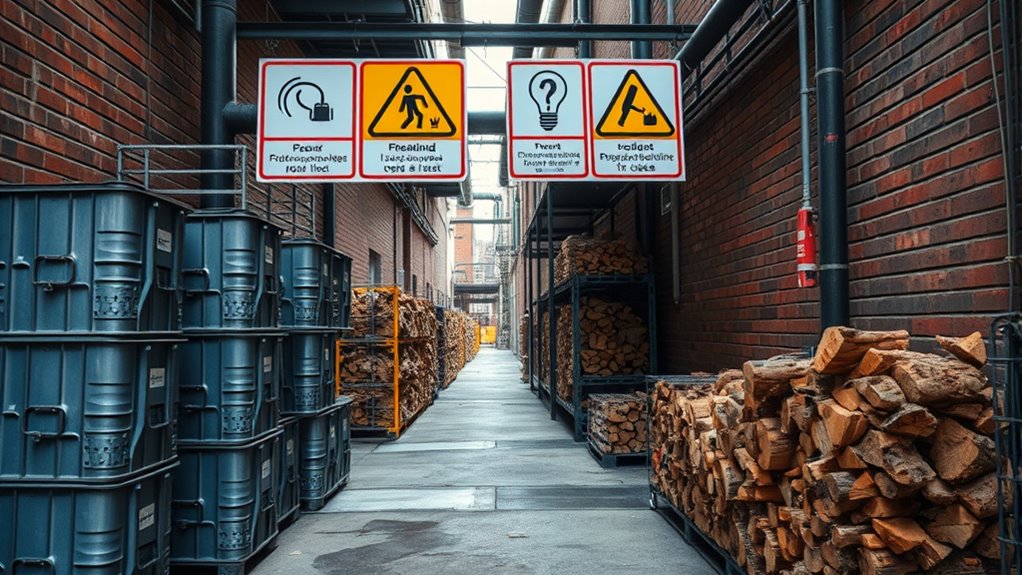
Using appropriate containers for storing firewood is essential for safety and efficiency. Fireproof containers protect your wood from moisture and reduce fire risks. Proper stack organization ensures easy access and prevents collapse. To optimize storage, consider these tips:
- Use fireproof containers to contain the wood safely.
- Keep stacks neat and stable to prevent accidents.
- Elevate containers off the ground to avoid moisture damage.
- Label storage areas for quick identification and organization.
Enforcement and Penalties
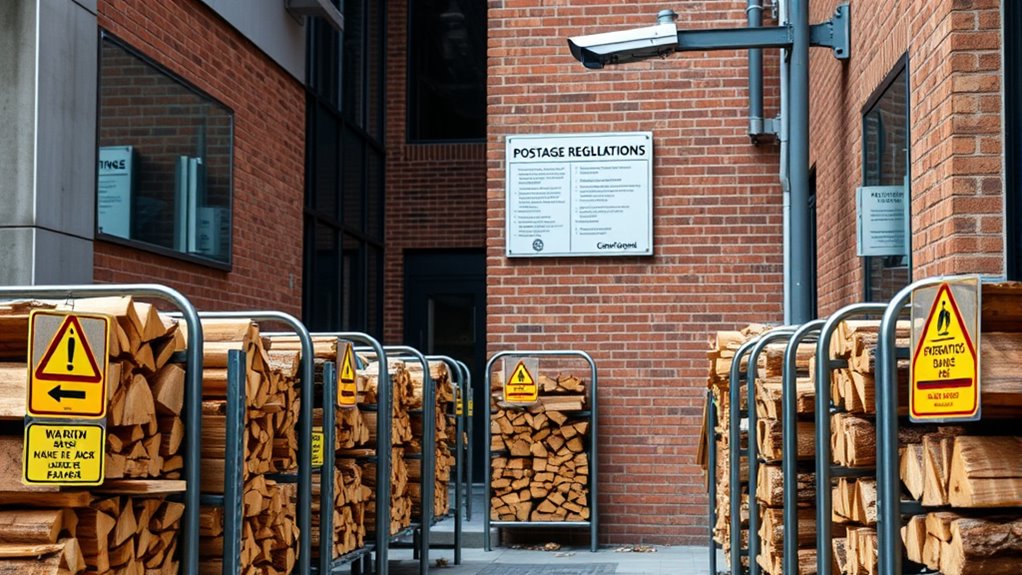
You need to be aware of the consequences if you violate firewood storage rules, as fines can add up quickly. Enforcement agencies are tasked with monitoring compliance and issuing penalties when necessary. Staying informed helps you avoid costly violations and guarantees you follow all regulations properly.
Violations and Fines
Are violations of urban firewood storage regulations taken seriously? Absolutely. If you overlook the rules, you risk facing fire code violations that could lead to fines or other penalties. Penalty assessments vary depending on the severity of the violation and whether it’s a repeat offense. To understand your potential consequences, consider these key points:
- Ignoring storage guidelines may result in immediate fines.
- Repeated violations can lead to increased penalty assessments.
- Fire code violations could also trigger mandatory corrective actions.
- Fines can accumulate until the violation is resolved or addressed.
Being aware of these fines emphasizes the importance of proper firewood storage. Stay compliant to avoid unnecessary penalties and ensure safety in your neighborhood.
Enforcement Agencies
Enforcement of urban firewood storage regulations is typically carried out by local fire departments and municipal code enforcement agencies. These agencies ensure compliance with fire safety standards and promote community safety. When violations occur, they issue citations or fines to encourage adherence. Penalties are designed to motivate property owners to store firewood responsibly, reducing fire hazards. Your cooperation helps maintain a safe environment for everyone.
| Enforcement Agency | Responsibilities |
|---|---|
| Local Fire Departments | Inspect storage, uphold fire safety laws |
| Municipal Code Enforcement | Issue citations, monitor compliance |
Frequently Asked Questions
Are There Specific Firewood Size Restrictions?
You might wonder if there are firewood size restrictions. Typically, regulations focus on firewood dimensions and storage container sizes, ensuring safety and cleanliness. You should check local rules to see if there are specific limits on firewood length or thickness. Using appropriately sized storage containers helps keep your firewood organized and compliant. Always measure your firewood and choose containers that fit well without overcrowding or creating hazards.
Can I Store Firewood Indoors?
You can store firewood indoors, but you should consider indoor humidity levels to prevent excess moisture, which can cause mold. Proper ventilation helps maintain a healthy environment. Additionally, storing firewood indoors requires firewood pest control, as pests like termites or beetles can hitch a ride inside. Keep the wood dry, away from walls, and check regularly for pests to guarantee safe indoor storage without risking damage or health issues.
How Often Should Firewood Be Rotated?
Rotating your firewood isn’t just a good idea—it’s essential for keeping pests at bay and ensuring safe burning. You should rotate your firewood every 6 to 12 months, depending on seasonal drying, to prevent mold and pests from spreading. This process helps the wood dry evenly and reduces the risk of infestations. Regular rotation keeps your firewood fresh, safe, and ready for cozy fires, transforming your space into a warm haven.
Are There Permits Required for Large Firewood Storage?
If you’re planning to store a large amount of firewood, you might wonder if you need firewood permits. Storage regulations vary by city or county, and some areas require permits for large firewood storage to ensure safety and compliance. Check with your local authorities or zoning office to understand specific storage regulations. Obtaining the necessary firewood permits helps you avoid fines and ensures your storage setup meets community standards.
What Are the Noise Considerations During Firewood Collection?
When gathering firewood, you should consider firewood noise and collection disturbance, especially in urban areas. Your activities might generate loud sounds that bother neighbors or disturb nearby residents. To minimize firewood noise, try collecting during daytime hours and keep equipment well-maintained. Being mindful of collection disturbance helps maintain good community relations. Always check local noise ordinances to ensure your firewood collection remains within acceptable limits.
Conclusion
Now that you know the rules, are you prepared to store firewood safely and legally? Ignoring these regulations might seem harmless, but the consequences could be far more serious than you realize. Will your storage setup keep pests out and fire hazards at bay, or will it invite trouble? Stay vigilant, follow the guidelines, and guarantee your firewood storage doesn’t become a hidden danger. The choice is yours—what will you do next?
